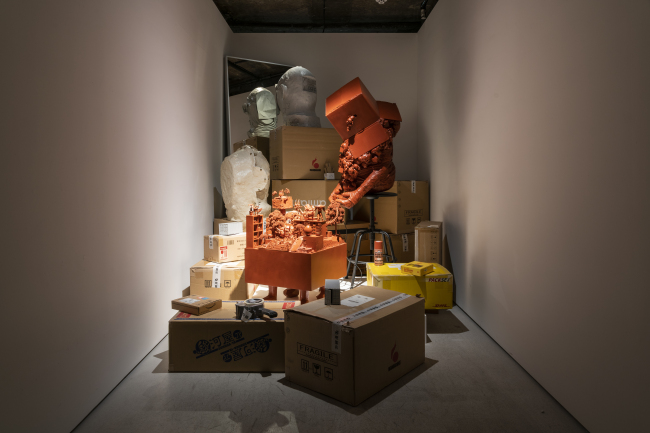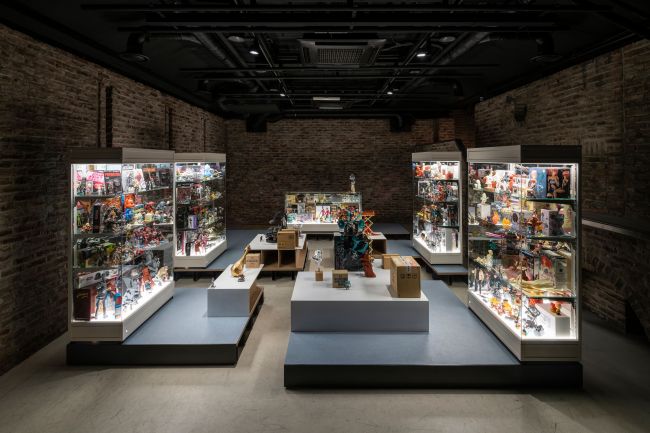In the contemporary art scene where everything -- installations and gallery spaces for instance -- tends to become bigger and bigger to achieve “spectacle” status, artist Don Sun-pil has brought miniature figurines of characters from cartoons, animations, games and other subculture productions into the gallery space.
Don is holding a solo exhibition at Arario Museum’s underground gallery at Space, an iconic architectural gem from Kim Soo-geun in central Seoul.
 |
Artist Don Sun-pil‘s “Next Back Door” (Arario Gallery) |
 |
An installation view of exhibition “Kitsutaiten” by artist Don Sun-pil at Arario Gallery in Space, Seoul (Arario Gallery) |
Don’s latest exhibition introduces some 400 figurines, part of the artist’s collection that ranges from the very first miniature he bought when he was a high school student -- from the “Spawn” series, made by US company McFarlane Toys -- to his own sculptural collages.
The exhibition “Kitsutaiten” at first glance appears to be a collection representing the artist’s personal taste. But, it is more about the artist’s critical statement on the figurines and the subculture they have created.
“I think I have come to hold such exhibition as I tried to look into the intersections between fine art and the subculture of miniature figures,” Don said at a press conference Tuesday at Arario Museum in Space.
As a collector and lover of the figurines, Don wanted to learn more about the subculture, as well as cultural criticism specific to his beloved small objects. But his hopes and expectations fell unfulfilled not long later.
“I was surprised by the fact that people are not bothered to make any kind of cultural criticisms regarding miniature figures, even though there are so many that have already been made and that are still being made,” Don said. “I found the criticisms and discourses that surround the miniature figures are very difficult to come by not just here, but also abroad,” he added.
Talks about figurines are typically limited to their transactional and financial value, according to the artist.
“In online communities, for instance, many people ask about the venues they can but miniature figures or the ways they can get them cheaper. But they don’t talk about why they like them for instance,” Don said.
Don has said that there is much more to talk about concerning the figurines and the culture that supports them, beyond their prices.
“People who collect those miniature figures have their own taste. The reasons that they collect them should be all different too. A person’s preference is based upon stories and contexts of the person. But not many are willing to talk about them perhaps because it is difficult to put it in words. I think it’s a shame,” Don said.
The artist said that figurines appeal to him more than sculptures because they better represent the ways in which people actually live.
“A miniature figure cannot be made by the efforts of a single individual. Many parties come into play when making figurines, such as customers, sculptors, the owner company of an original character and so on. A final product is a result of combining opinions and needs of those different parties,” Don said.
“Creating one’s own artistic world has no limit to it, and I admire those artists who do that. But I am interested in the areas that have limits -- like life is full of limits. What makes the miniature figures interesting is that they have limits,” Don continued.
Figurines also have limits in that they do not typically last long. But the artist finds attractions in those limits.
“Miniature figures easily break, and you have to deal with it. The thing is that I still like them even though their parts are broken. They don’t have to be in perfect shape. You might wish them to stay intact forever, but they cannot,” Don said.
“What is important is the shape of your memory. Like my first miniature figure reminds me of days in high school, those objects can bring back the memory that could have been forgotten otherwise,” Don said.
The artist’s more detailed takes on figurines and the corresponding subculture are available in his newly published book, “Figure Text: A Report on the Wonder Festival.”
“Kitsutaiten” runs through June 20.
By Shim Woo-hyun (
ws@heraldcorp.com)









![[Today’s K-pop] Blackpink’s Jennie, Lisa invited to Coachella as solo acts](http://res.heraldm.com/phpwas/restmb_idxmake.php?idx=644&simg=/content/image/2024/11/21/20241121050099_0.jpg)